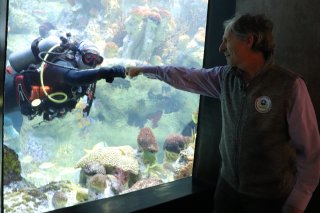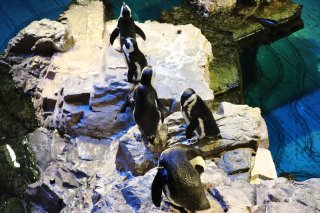Fifty Years Later
When I was in elementary school 50 years ago, my family traveled to Boston and headed to the New England Aquarium. I viscerally remember what it felt like to walk through the dark entrance halls, turn a corner and then stop before the spectacular Giant Ocean Tank. I was in awe, enchanted by the streaks of color, the light bouncing off coral, sharks, bright tropical fish, and the huge sea turtle gliding effortlessly above my head. In that moment, I was forever changed.
Last week I was at the aquarium again, celebrating the opening of an installation highlighting the work of EPA scientists and their partners in federal, state, and city government, universities and non-governmental organizations. Together, they mapped for the first time, New England’s blue blue carbon resources – coastal salt marshes and shallow eel grass beds that are the engines of carbon storage, storm protection, and nurseries for countless marine organisms.

At the event, I was able to connect these visits, 50 years apart, in my head and heart, in ways I never had before. What forever changed in me, or rather, what was planted in me when I was eight, was the seed that grew into a deep appreciation for the ocean and humanity’s part in its dynamic, spiritual and wondrous marvel. A seed that would be nurtured by curiosity and science, that would flourish into a passion for protecting and sustaining the resources we are a part of and dependent on. This seed of curiosity would produce a deeper understanding of how environmental protection and human justice are inexorably intertwined.
I also reflected on changes within a lifetime. In the early 1970s, the Boston Harbor was one of the most polluted bodies of water in the country. Thanks to the Clean Water Act, today it is clean and an engine of economic development and recreation. Fifty years ago, climate change was barely understood and its impacts unfelt. Today, floods and wildfires, heat islands and unprecedented rain and snow, droughts and climate-fueled famine and migration are in the daily headlines affecting lives, especially those in low income and disadvantaged communities.

My daughters are in their mid-twenties, and of course, I took them countless times to stand before the Giant Ocean Tank. In 50 years, what will my generation leave to them? I don’t know. But I know that standing before those streaks of fish and turtles last week, I continue to be inspired to do my best to ensure the world they inherit is healthier than the one I inherited.

About the Author
David Cash
Regional Administrator
Region 1
David W. Cash has spent his career in public service harnessing science, innovative policy and participatory decision-making to solve challenges and seize opportunities at the intersection of environment, economy and equity. He and his wife Annie Weiss, a psychotherapist, live in the Boston area and have two young adult daughters, who are both pursuing careers in addressing systemic climate injustice and ecosystem health.
Editor’s Note: The views expressed here are intended to explain EPA policy. They do not change anyone’s rights or obligations. You may share this article. However, please do not change the title or the content, or remove EPA’s identity as the author. If you do make substantive changes, please do not attribute the edited title or content to EPA or the author.
EPA’s official web site is www.epa.gov. Some links on this page may redirect users from the EPA website to specific content on a non-EPA, third-party site. In doing so, EPA is directing you only to the specific content referenced at the time of publication, not to any other content that may appear on the same webpage or elsewhere on the third-party site, or be added at a later date.
EPA is providing this link for informational purposes only. EPA cannot attest to the accuracy of non-EPA information provided by any third-party sites or any other linked site. EPA does not endorse any non-government websites, companies, internet applications or any policies or information expressed therein.
